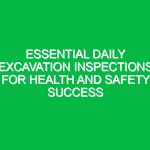Introduction
In the realm of Health, Safety, and Environment (HSE), understanding the concept of a near miss is crucial. But what exactly does it mean when we define a near miss? A near miss refers to an incident where an accident or injury could have occurred but did not, often due to chance or an intervention that prevented it. Recognizing and analyzing these events is vital for organizations aiming to improve Safety Measures, reduce workplace Hazards, and foster a culture of proactive risk management.
Near misses serve as early warning signs that can reveal weaknesses in Safety protocols and highlight areas needing improvement. By learning from these incidents, organizations can implement strategies that not only prevent future accidents but also enhance their overall Safety culture. In this article, we will delve deeper into the significance of near misses in the HSE domain, explore their implications, and discuss Best Practices for effectively managing them.
Defining a Near Miss
To fully appreciate the importance of near misses in HSE, we must first clarify the term itself. A near miss is an event that could have resulted in harm, injury, or damage but did not, either due to fortunate circumstances or timely interventions. For instance, if a worker drops a heavy tool and it narrowly misses another employee, that situation qualifies as a near miss. The danger was real, yet the outcome was avoided.
Near misses often go unreported or unnoticed, yet their analysis can provide invaluable insights. By acknowledging these incidents, organizations can identify patterns that may indicate systemic issues within their safety practices. This proactive approach to risk management not only helps prevent actual accidents but also cultivates a culture where safety is prioritized and everyone feels responsible for maintaining it.
Key Aspects of Near Misses in HSE
1. The Importance of Reporting Near Misses
Reporting near misses is fundamental for effective HSE management. Many organizations struggle with a culture of silence surrounding near misses, fearing repercussions or believing that reporting is unnecessary. However, creating an environment where employees feel safe to report near misses is crucial.
Benefits of Reporting Near Misses
- Enhanced Safety Awareness: When employees report near misses, it raises awareness about potential Hazards, prompting a collective effort to improve Safety Measures.
- Root Cause Analysis: Investigating near misses allows organizations to identify underlying issues that may lead to more severe incidents.
- Improved Training Programs: Data from near miss reports can inform training initiatives, helping employees recognize and avoid potentially dangerous situations.
- Cultural Shift: Encouraging reporting fosters a culture of safety, where employees feel their input is valued and necessary.
2. Analyzing Near Misses: Steps and Methodologies
Once near misses are reported, the next crucial step is analysis. This involves a structured approach to understanding the events leading up to the near miss and identifying what went right and what could have been improved.
Steps for Analyzing Near Misses
- Collect Data: Gather all relevant information about the near miss, including who was involved, when and where it occurred, and the circumstances surrounding it.
- Conduct Interviews: Speak with those involved and any witnesses to gain insights into the events and contributing factors.
- Identify Contributing Factors: Look for patterns or systemic issues that may have contributed to the near miss. This could include inadequate training, equipment failure, or environmental conditions.
- Implement Corrective Actions: Based on the analysis, develop and implement actions to address the identified issues and prevent recurrence.
- Follow Up: Monitor the effectiveness of the corrective actions and make adjustments as necessary.
3. Potential Hazards and Risks Associated with Near Misses
While near misses themselves do not result in harm, they often indicate underlying risks that could lead to actual accidents. Understanding these potential hazards is essential for an effective HSE strategy.
Common Hazards Indicated by Near Misses
- Inadequate Training: Lack of proper training may increase the likelihood of near misses, as employees may not recognize hazards or know how to respond appropriately.
- Equipment Malfunction: Near misses can indicate that machinery or tools are not functioning correctly, which may lead to more severe incidents if not addressed.
- Poor Communication: Miscommunication among team members can result in unsafe conditions. Near misses often highlight the need for clearer communication protocols.
- Unsafe Working Conditions: Environmental factors, such as cluttered workspaces or inadequate lighting, can contribute to near misses and point to the need for workplace improvements.
Best Practices for Managing Near Misses
To effectively manage near misses, organizations should adopt several Best Practices that encourage reporting, facilitate analysis, and promote ongoing improvements in safety protocols.
1. Establish a Reporting System
Creating a user-friendly reporting system is essential for encouraging employees to report near misses. This system should be simple to use, anonymous if desired, and easily accessible. By reducing barriers to reporting, organizations can increase the volume and quality of near miss data collected.
2. Foster a Culture of Safety
Cultivating a culture where safety is prioritized can significantly impact the reporting and management of near misses. This involves leadership commitment, continuous training, and open communication. Employees should feel empowered to speak up about safety concerns without fear of retribution.
3. Regular Training and Awareness Programs
Implementing ongoing training programs focused on safety awareness and near miss reporting can enhance employees’ understanding of potential hazards. Training should include real-life scenarios, encouraging participants to think critically about safety practices.
4. Conduct Regular Safety Audits
Regular safety audits can help identify potential risks before they result in near misses or actual accidents. These audits should assess the effectiveness of safety protocols, equipment Maintenance, and overall workplace conditions.
5. Learn from Near Misses
Emphasizing the importance of learning from near misses can transform them into valuable learning opportunities. Create forums or meetings where near misses are discussed, allowing employees to share their experiences and insights.
Regulations and Standards Governing Near Misses
Understanding the regulatory framework surrounding near misses is vital for compliance and effective HSE management. Various Regulations may mandate the reporting of near misses and the implementation of safety protocols to prevent incidents.
1. Occupational Safety and Health Administration (OSHA)
In the United States, osha plays a crucial role in Workplace Safety. While OSHA regulations primarily focus on recordable injuries and fatalities, they encourage organizations to track near misses as part of their safety management systems. By doing so, employers can demonstrate their commitment to safety and compliance.
2. International Organization for Standardization (ISO)
ISO standards, such as ISO 45001 for Occupational Health and safety management systems, emphasize the importance of hazard identification and risk assessment. These standards advocate for organizations to include near miss reporting as part of their overall safety strategy, thus highlighting the significance of these incidents in preventing future accidents.
3. Industry-Specific Regulations
Many industries have specific regulations governing safety practices, which may include directives related to near misses. For example, the oil and gas industry has strict guidelines for reporting and analyzing near misses due to the high-risk nature of the work. Organizations must stay informed about industry regulations to ensure compliance and protect their workforce.
Conclusion
In conclusion, understanding and effectively managing near misses is paramount for fostering a safe working environment. By defining a near miss and emphasizing its significance within the HSE context, organizations can take proactive steps to prevent accidents and enhance safety protocols.
The process of reporting, analyzing, and learning from near misses not only mitigates risks but also contributes to a culture where safety is seen as a shared responsibility. As we continue to prioritize health, safety, and environmental Sustainability, recognizing the value of near misses will remain a critical component of effective HSE management.
Encouraging open dialogue about near misses and implementing best practices can lead to substantial improvements in Workplace Safety, ensuring that potential hazards are addressed before they lead to actual harm. Ultimately, by understanding near misses, we can build a safer future for all.


